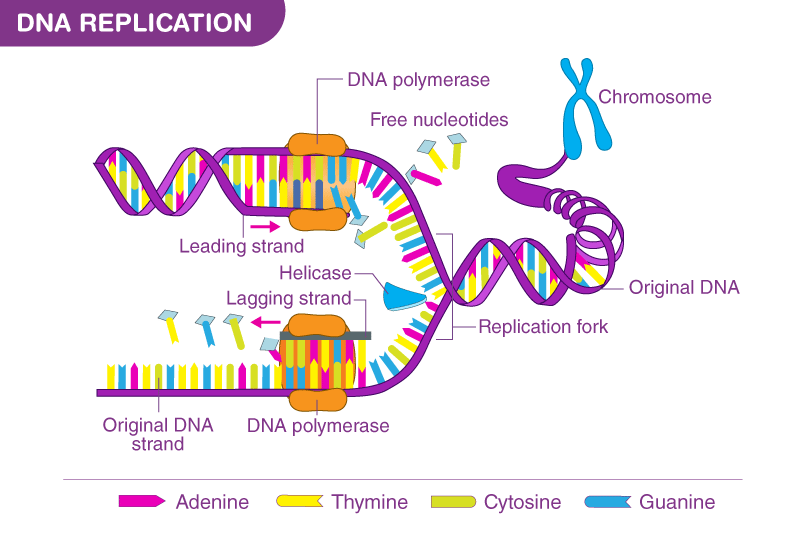2.1 – DNA STRUCTURE AND REPLICATION
| 10 Students |
| Grade 11-12 |
COURSE DESCRIPTION
The structure of DNA was proposed by Watson and Crick in 1953. With an understanding of structure, experimental evidence supported the proposal that DNA replicates in a semi-conservative manner. The Central dogma States that genetic information is encoded in the DNA and transferred to the mRNA during transcription. In addition to mRNA transcription, tRNA are transcribed; tRNA is needed during translation while rRNA is a component of ribosomes. In eukaryotic transcription, pre-mRNA is synthesized and then processed to produce nature mRNA. Subsequently, through translation, the information on the mRNA is used to syn es polypeptides, which are folded into functional proteins.
Learning Outcomes
2(a) describe the structure and roles of DNA and RNA (tRNA, rRNA and mRNA) (knowledge of mitochondrial DNA is not required)
2(b) describe the process of DNA replication and how the end replication problem arises
Use the knowledge gained in this section in new situations or to solve related problems
Lecture Outline
- Role of DNA: As the Hereditary Material
- Structure of DNA
2.1. The Building Blocks of Nucleic Acids – Nucleotides
2.1.1 Pentose Sugar
2.1.2 Nitrogenous Bases
2.1.2.1 Nucleoside = Pentose + Nitrogenous Base
2.1.2.2 Nucleotide = Nucleoside + Phosphate Group
2.1.3 Formation of Dinucleotides and Polynucleotides
2.1.4 Polarity / Directionality in a Polynucleotide
Concept Check 1
2.2. Physical structure of DNA
2.2.1 The Double-Helix: Road to Discovery
2.2.2 structure of DNA: The Double-Helix 14 2.2.3 The Double-Helix: Main Features
2.2.4 Packing of DNA in Eukaryotic Chromosomes
2.2.5 stable, Invariant storage of Genetic Information
- Replication of DNA
3.1. DNA Strands as Templates for Replication
3.2. Models of DNA Replication
3.2.1. The Meselson-Stahl Experiment: Evidence for Semi- Conservative Replication
Concept Check 2
3.3. Mechanism of DNA Replication
3.3.1 Location of Origins of Replication
3.3.2 Separation of Parental DNA Strands
3.3.3 Synthesis of RNA Primers 3.3.4 Synthesis of Daughter DNA Strands
Requirements
- Donec porta ultricies urna, faucibus magna dapibus.
- Etiam varius tortor ut ligula facilisis varius in a leo.
- Folutpat tempor tur duis mattis dapibus, felis amet.
- Donec porta ultricies urna, faucibus magna dapibus.
- Etiam varius tortor ut ligula facilisis varius in a leo.
- Folutpat tempor tur duis mattis dapibus, felis amet.
What is the target audience?
- This course is intended for anyone interested in learning to master his or her own body.
- This course is aimed at beginners, so no previous experience with hand balancing skillts is necessary
Aenean viverra tincidunt nibh, in imperdiet nunc. Suspendisse eu ante pretium, consectetur leo at, congue quam. Nullam hendrerit porta ante vitae tristique. Vestibulum ante ipsum primis in faucibus orci luctus et ultrices posuere cubilia Curae; Vestibulum ligula libero, feugiat faucibus mattis eget, pulvinar et ligula.
CURRICULUM
Section 1: Introduction to Handstands
Section 2: Reference Material, Moodboards and Mind Mapping
Wrist Strengthening
While your wrists will certain get stronger from practice and grow accustomed to the stress of the skill, a basic amount of wrist strengthening exercises for several weeks can only help things. I’d recommend working wrist curls and reverse wrist curls for around 6-10 reps for 3 sets. I also strongly recommend trying some sledgehammer levering. Work in 2-3 sets of 3-5 reps. In particular, exercises 1 and 3 are fantastic for building wrist strength and they are much harder than they look! Start with them to get the hang of sledgehammer work before you progress to the other two exercises. I don’t want somebody putting a hole through their floor or their face because they rushed things!Section 3: Sketching out Ideas
- The main objective to the sketching process is to generate super rough thumbnail sketches of what we feel best visually communicates the highlighted words from our mind maps.
- Take as much time as you need for this step — this might be 10 minutes or it might be 10 days.
- Personally, I like to work quickly and try not to analyze or elaborate too much.
- Now, that doesn't mean you should only create a handful of sketches.
- Even though this step only took a couple of hours, I was still able to put over 100 thumbnails on paper.
- The whole point of this process is to flush out the bad ideas and narrow down the good ones until we find that one layout that really speaks to us.
- Also, keep in mind the project brief and have your list in front of you as a reference to avoid getting sidetracked.
- Remember—detail is not needed. Simply flush out the bad ideas and find a great direction.
- Once I feel I have a good direction with the sketches, I'm now ready to take a quick photo with my phone and import it into Illustrator.
Section 4: Conclusions and Evaluation
About Instructors
Reviews
Average Rating
Detailed Rating
| Stars 5 |
|
0 |
| Stars 4 |
|
0 |
| Stars 3 |
|
0 |
| Stars 2 |
|
0 |
| Stars 1 |
|
0 |
Be the first to review “2.1 – DNA STRUCTURE AND REPLICATION” Cancel reply
| 10 Students |
| Grade 11-12 |



There are no reviews yet.